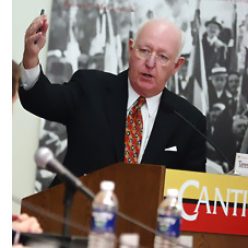With the late and unlamented 2020 receding from mind and memory, it is tempting to hope that the racial reckoning the country experienced in that not very good year in the wake of the brutal killings of George Floyd and Breonna Taylor and others will bring about real and lasting change in racial attitudes and our national culture.
There is no guarantee, of course, given our long and painful history. The real change hoped for after the assassination of Dr. Martin Luther King Jr. and the riots and disruptions of the 1960’s and 1970’s largely evaporated in the reactionary 1980’s. Why should the 2020’s be different?
There are some hopeful signs: the reach and impact of the Black Lives Matter and Me, too movements, the greater sensitivity and inclusion in everything from President-elect Joe Biden’s vice presidential and cabinet selections to popular culture, advertising, corporate boardrooms, politics and, finally, believe-it-or-not, media. You see it everywhere, from the profusion of minority anchors on television to the reporters on the beat; from the increasing numbers of African-Americans featured in mass advertising to the promotion of women to the top executive ranks.
One huge breakthrough that got insufficient attention in December, 2020, was the elevation of Rashida Jones, a 39-year-old, African-American television executive to the presidency of MSNBC. As the first Black woman to take charge of a major television news network, Ms. Jones is shattering a glass ceiling and joining a former fraternity that has been almost exclusively White and mostly male. There are notable exceptions, like Susan Zirinsky at the head of CBS News, but they are not the rule.
Rashida Jones rocketed up the executive ranks, producing presidential debates and town halls, overseeing daytime news coverage for MSNBC and breaking news and specials for NBC’s broadcast news divisions. But her selection as president would not have been a given prior to the traumatic racial justice and cultural tumult of 2020. Now it seems natural, appropriate and, if anything, overdue.
Old habits and attitudes die hard, however: The New York Times article announcing her appointment not only was inside the paper at the bottom of a page, the piece devoted most space to the career and favorite pastimes of Phil Griffin, the white male she was replacing. Griffin is a fine fellow, apparently leaving on his own timetable, but really…
Another media breakthrough in late December occurred not among the coastal elites but in Kansas City, where one of the Midwest’s most influential newspapers apologized for decades of racist coverage of its own community. In a striking letter to readers, Mike Fannin, editor of the venerable Kansas City Star, wrote that the newspaper “disenfranchised, ignored and scorned generations of Black (note the capitalization) Kansas citizens.” He wrote that the paper had “reinforced Jim Crow law and redlining.” Fannin pointed to the May 25 death of George Floyd in Minneapolis and the firestorm that followed as the impetus for what he promised would be an “honest examination” of the paper’s past in its own pages.
As the readers of The Annapolis Capital read last June when it recalled its own racist writings, The Star was not the first newspaper to re-examine its past performance, but it was impressive nonetheless.
Three months earlier, the publisher of a larger and influential U.S. newspaper, the Los Angeles Times, acknowledged its own “blind spots” on race and promised to openly acknowledge its past biases. Its public apology said the staff was beginning the process of “acknowledging” past biases and promised that its newsroom will not tolerate prejudice. This stood out even in the in the strongly blue, supposedly progressive California.
And, just this week, another change in the media world: the estimable Mark Shields, who stepped down after 33 years from his regular Friday night punditry post opposite David Brooks on The PBS NewsHour, was replaced by Jonathan Capehart, a 53-year-old, Black and openly gay man. Capehart, who won a Pulitzer Prize for his editorial writing at The Washington Post, will give the Friday night feature a different look.
Will the Black Lives Matter and Me, Too movements blossom further in 2021? Will the transformation in the media world and beyond continue?
As they say on television, stay tuned.
